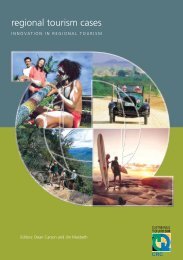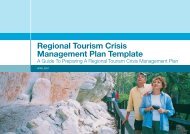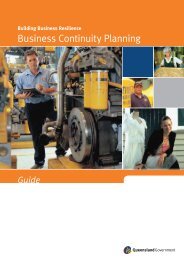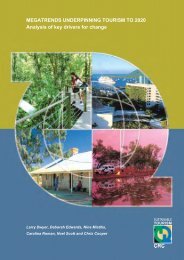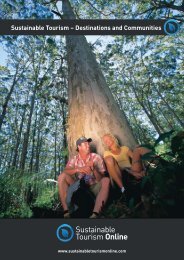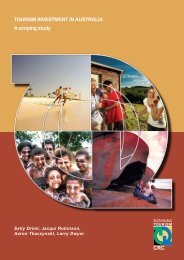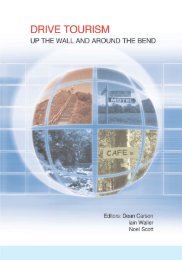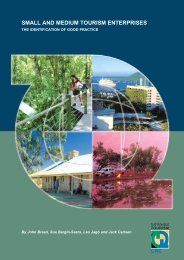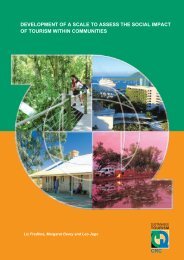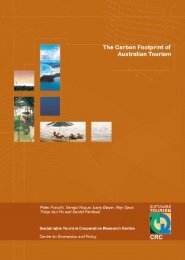Tourism Risk Management - Sustainable Tourism Online
Tourism Risk Management - Sustainable Tourism Online
Tourism Risk Management - Sustainable Tourism Online
Create successful ePaper yourself
Turn your PDF publications into a flip-book with our unique Google optimized e-Paper software.
ounty for any information leading to the capture of Abu Sayyaf leaders and followers involved in<br />
the kidnapping (Hookway, 2001). AFP operations have apparently reduced Abu Sayyaf strength<br />
from the level of over 1000 in early 2000 to below 100 on Basilan and 500 on Jolo by December<br />
2001 (Niksch, 2003).<br />
US Involvement in Combating Terrorism<br />
Beginning in October 2001, The United States sent groups of military observers to Mindanao to<br />
assess AFP operations against Abu Sayyaf, render advice and examine AFP equipment needs.<br />
President Bush extended $93 million aid to the Philippines when President Arroyo visited<br />
Washington in 2001. However, President Arroyo insisted that the US military role should be<br />
advisory and that the AFP would retain full operational responsibility. By late December 2001, the<br />
AFP on Mindanao began to receive quantities of US military equipment (Niksch, 2003). Although<br />
terrorism remained active afterwards, President Arroyo reiterated that US troops would not be<br />
allowed to fight Muslim rebels in the southern Philippines (Anonymous, 2003).<br />
(Source: Based upon material provided by the Hong Kong Polytechnic University)<br />
Government travel advisories are clearly attaining a higher profile in the decision making of travellers<br />
and travel professionals on the suitability of tourism destinations. Consequently, there is a growing<br />
need to ensure that the information and warnings are credible, responsible, and based on a sober<br />
assessment of security risks, and that they are as free of political or cultural considerations as<br />
possible.<br />
From early 2003 the Australian travel industry sought and undertook a greater dialogue with DFAT to<br />
ensure that the tourism industry’s perspective was given due consideration in the formulation of<br />
advisories. DFAT, to its credit, was responsive to tourism industry overtures. As a result of extended<br />
negotiations conducted by representatives of Australian travel industry companies and associations<br />
under the auspices of Australian Federation of Travel Agents (AFTA), the Australian travel industry<br />
and DFAT (2003b) released the Charter for Safe Travel in June 2003.<br />
Charter for Safe Travel<br />
The Charter commits the Australian travel industry to disseminate Australian government travel<br />
advisories to travellers but it also commits the Australian government to maintaining a consultative<br />
dialogue with the travel industry and to include travel agents, airlines and tour operators as credible<br />
sources in determining the safety of destinations. The Australian Charter for Safe Travel is a model<br />
that tourism industries of many countries can adapt. It has the potential to be a precursor to the<br />
travel industry playing a global role in helping all governments determine travel advisories.<br />
Participating partners receive a certificate representing their commitment to the Charter’s principles.<br />
(Source: Courtesy of the Department of Foreign Affairs and Trade, Australia)<br />
<strong>Tourism</strong> <strong>Risk</strong> <strong>Management</strong> – An Authoritative Guide to Managing Crises in <strong>Tourism</strong> 85



